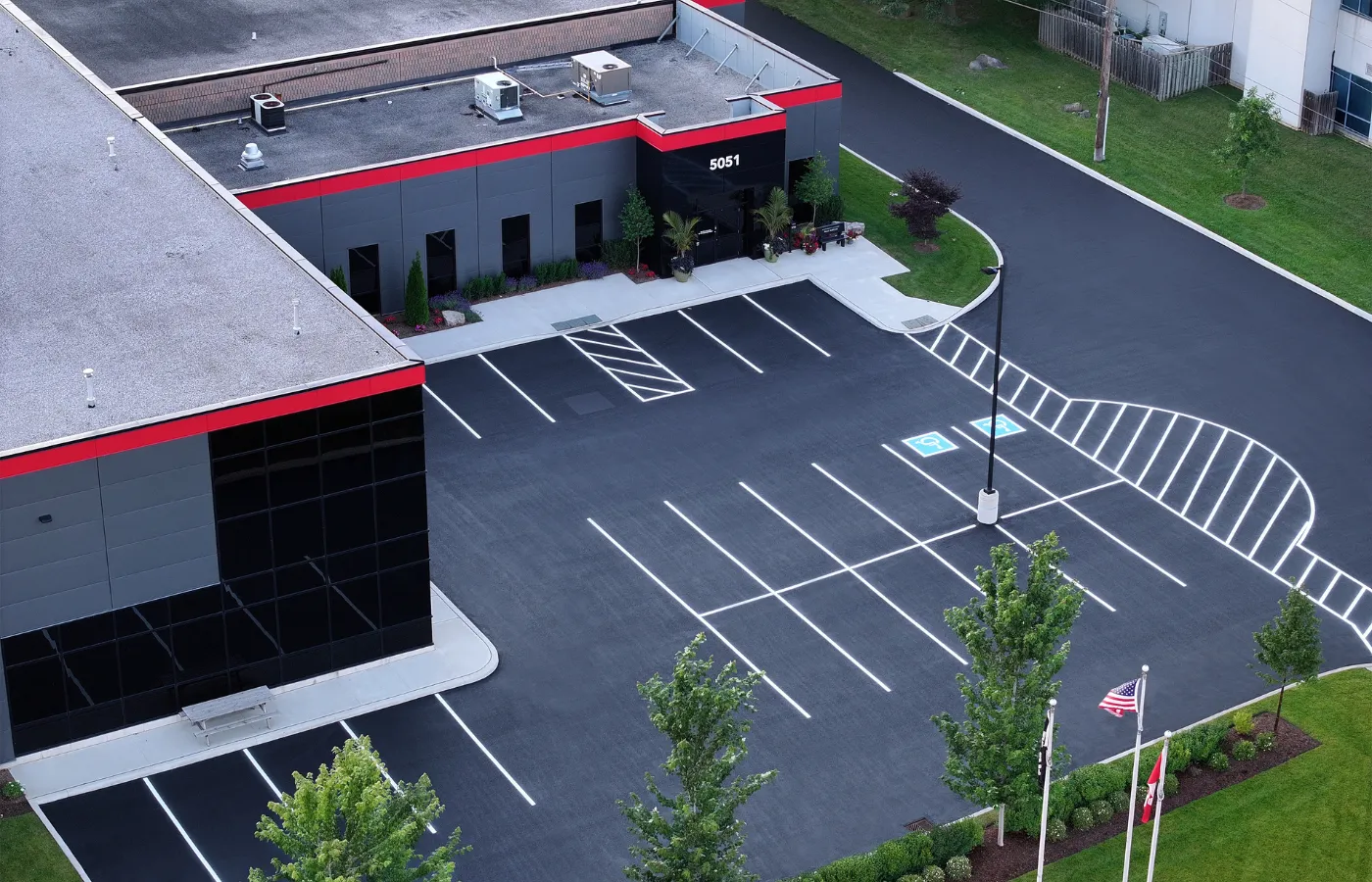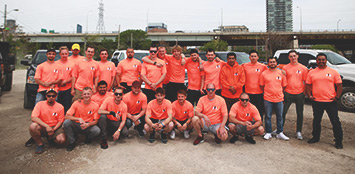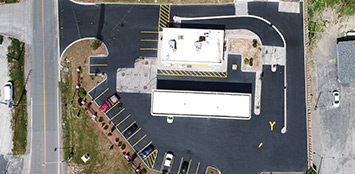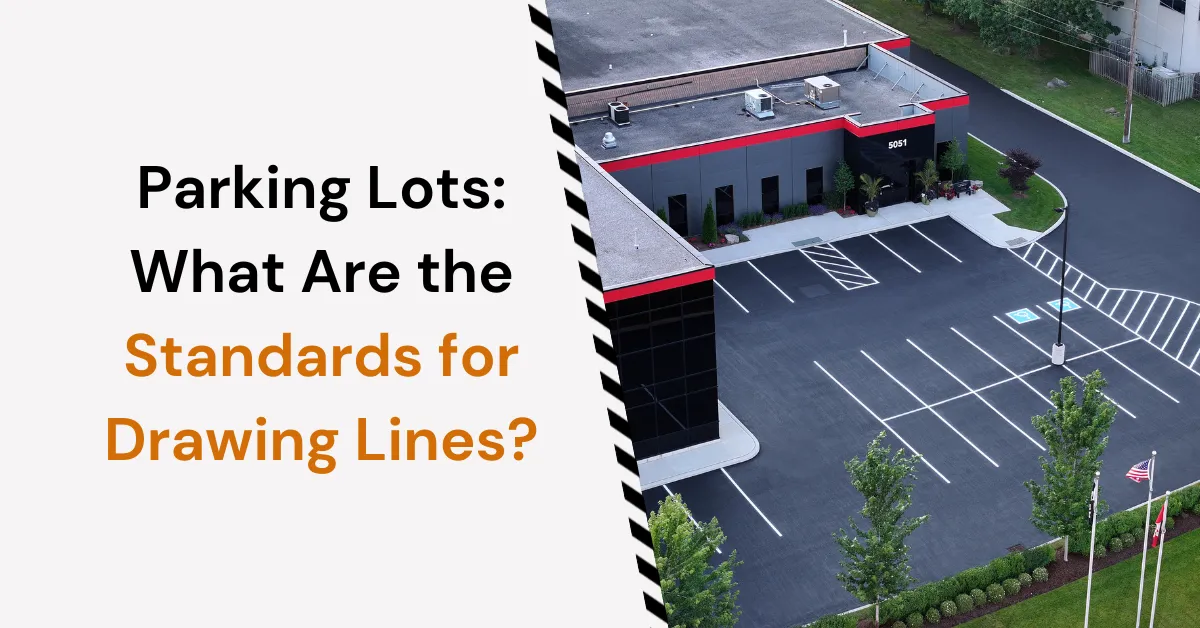If you have ever pulled into a parking lot where the lines were faded or barely visible, you know how disorienting and frustrating it can be. Parking lot stripes are not just cosmetic, they are needed to help keep things organized, safe, and accessible. From a small store in Scarborough to a busy shopping centre in Brampton, nicely painted lines help people park correctly, stop fender benders, and ensure everyone, including those with disabilities, has a fair and safe spot to park.
So what are the rules and regulations of painting parking lot lines in Toronto and the GTA? Here is all you need to know.
1. Line Dimensions: How Wide Are Parking Lines?
In most places across the GTA, the standard width for a parking line is about 4 inches. It’s wide enough to be seen easily but not so wide that it takes up too much space. You’ll usually see these lines in white for regular parking stalls and yellow when the space is reserved or used for something specific, like a loading area or visitor zone. The goal is to keep things clear and easy to understand at a glance.
2. Parking Spot Sizes: How Big Is a Regular Stall?
A typical parking stall in Toronto is about 2.6 metres wide and 5.6 metres long. That gives most vehicles enough room to park comfortably without worrying about someone dinging your door. For smaller cars, compact spots are slightly smaller, and for trucks or service vehicles, spaces may be made a bit larger to fit the size of the vehicle. The city sets these dimensions to balance space efficiency and usability, especially in tight urban lots.
3. Accessible Parking Spaces: What’s Required?
Parking lots also need to include accessible parking spots, which are required under Ontario’s AODA (Accessibility for Ontarians with Disabilities Act). These spaces must be wider to allow enough room for mobility aids and vans with ramps or lifts. An accessible spot typically includes an extra access aisle next to it, painted blue with clear signage to indicate it’s reserved. These spots are usually placed close to building entrances for easy access. If you don’t include them or don’t follow the rules, you’re looking at potential fines and non-compliance issues.
4. Angled or Straight Parking: What Works Best?
From a layout perspective, owners can choose between angled and straight (90-degree) parking. Angled parking is often easier to navigate, especially in smaller lots or where traffic is one-way. It’s also faster for drivers to park and exit. Straight parking fits more cars in the same space but is harder to navigate, especially in tight spaces. The best option usually depends on the size and shape of your lot, as well as the volume of traffic it gets every day.
5. Traffic Directional Arrows and Markings
Parking stripes are not everything about where to park your car. Directional arrows and other road markings play a big role in safely moving automobiles through a lot. These markings direct drivers, reduce confusion, and prevent wrong-way driving.
You’ll often see arrows near entrances and exits, crosswalks for pedestrians, and stop bars at intersections within the lot. These details might seem small, but they make a big difference in how safe and smooth things run.

6. Fire Lanes and No-Parking Zones
There are certain areas in a parking lot in which vehicles never have to stop, and these need to be marked. Fire lanes are important for reaching emergency vehicles and must at all times be open. Most of them are red-painted and inscribed in large letters with the words “NO PARKING – FIRE LANE.” The remaining no-parking areas, like along loading docks or dumpsters, should also be well marked to prevent congestion and safety hazards.
7. Paint: Why Quality & Durability Matter
With Toronto’s extreme combination of hot summers and cold winters and everything in between, cheap paint just doesn’t cut it. This is why it’s necessary to have high-quality paint that’s designed to withstand the elements and is made for outdoor use. Some paints even have reflective properties to make them easier to see at night. Eventually, even the best paint will fade, so regular touch-ups are essential. Based on traffic volume and weather, most lots must be repainted every one to two years.
Learn more about factors that affect the lifespan of your parking lot line stripping here!
8. Staying Compliant with Local Bylaws
Different municipalities and cities may have specific rules when it comes to parking lots. In Toronto, for example, there are very specific bylaws that dictate the width of parking spaces, the minimum number of accessible spaces to have to accommodate, and even how far lines have to be from curbs or building doors. Before any painting, it’s wise to double-check the zoning department of your city or, better yet, hire a contractor who already has all the knowledge about the rules.
DIY vs. Professional Line Painting: What’s the Better Option?
If you’re thinking about refreshing your parking lot lines, you might wonder whether it’s something you can do yourself or if it’s worth hiring a professional crew. At first glance, a can of paint and a stencil might seem like a cheaper route, but in reality, line painting is more technical than it looks.
Here’s a quick comparison to help you decide:
Feature |
DIY Approach |
Professional Service |
| Initial Cost | Lower upfront | Higher, but includes expertise |
| Equipment Needed | Basic (rollers, stencils, tape) | Commercial-grade striping machines |
| Paint Quality | Consumer-grade (may fade quickly) | Durable, weather-resistant coatings |
| Compliance with Bylaws | Often overlooked | Fully compliant with local regulations |
| Accuracy of Layout | May be uneven or misaligned | Precise and measured |
| Time Required | Longer, especially without help | Fast and efficient |
| Longevity of Results | Needs more frequent touch-ups | Long-lasting and professional finish |
While DIY might work for a tiny private lot or a temporary fix, most commercial and residential properties in Toronto benefit from hiring professionals. Not only do you avoid the headache of measuring, stenciling, and repainting, but you also get peace of mind knowing the work meets city standards.
And let’s be honest, if the lines are crooked, too narrow, or fade within a few months, you’ll end up spending more to fix it later anyway. When you book professional services, you also have the option to book sealcoating for your parking lot for a complete refresh!
Line Painting For Parking Made Easy
Line painting is not necessarily the most exciting part of property maintenance, but it’s one of the most important. Done right, it makes your lot safe, efficient, and compliant. Done wrong, it can be a mess, create complaints, and even lead to fines. If your lines are fading away or your layout could use a facelift, chances are it’s time to call in a pro.
Here at Action Paving, we help property owners across Toronto and the GTA keep their lots in the best possible shape with professional line painting that meets all their requirements. From a minor touch-up to a full redesign, we will get your lot looking its best, staying safe, and performing as you require it to.
Do you require parking lot line painting services in Toronto or the GTA? Contact us today at Action Paving, we’ve got you covered.



